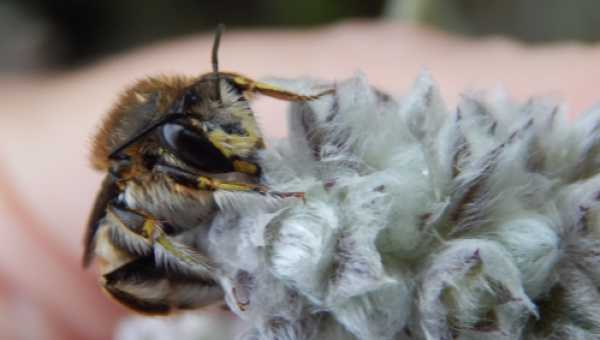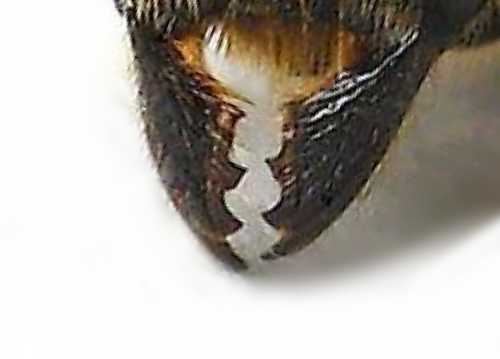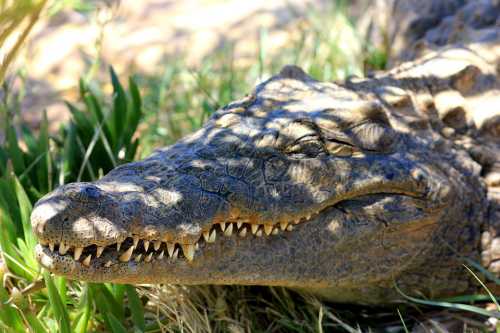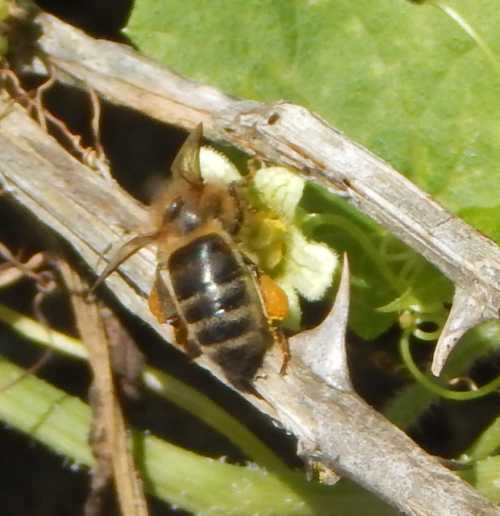Do Bees Have Teeth?
Date: 19th April 2020
Do bees have teeth?
The short answer is:
Yes....and no! In a sense bees do indeed have teeth on their mandibles (jaws), but they are not 'teeth' like those found in the mouths of humans or other mammals. Instead, the mandibles are 'toothed' with narrow or rounded points. However, these 'teeth' are really extensions of the mandibles.
Some bees have very few 'teeth' on their mandibles, whereas other species have more teeth present on the mandibles.
Now for more detail.....
Bees And Their 'Teeth'
Here is a very nice little quote from the book The Bees In Your Backyard by Wilson and Messinger-Carril:
"At the tip of the mandibles (the end farthest from the connection to the face) are a number of teeth. Some bees have very simple mandibles with few teeth, whereas others have many teeth that may be pointed or rounded".
 Wool carder bee.
Wool carder bee.Location and appearance of teeth on bees
The mandibles (jaws) look like small pincers and they are at the front of the face. Below is a photograph of the mandibles of a Megachile species of bee.
See how the mandibles are 'toothed' - note the pointed, jagged 'teeth' along the edges.
 Image of mandibles on a Megachile bee, showing 'teeth'.
Image of mandibles on a Megachile bee, showing 'teeth'.
Still not convinced?
It may seem strange to think of bees having teeth, but this is largely because when we think of teeth, we picture the teeth in a human or perhaps a dog or horse. Or maybe even a shark or crocodile....
 Bees' teeth are nothing like those of a crocodile!
Bees' teeth are nothing like those of a crocodile!
This brings us to the key question....
What is a tooth / what are teeth?
Of course, the word 'teeth' is merely the plural of 'tooth'. For humans (and other animals), teeth are hard, enamel-coated structures in the jaws, and they are used for biting and chewing.
However, the word 'tooth' can be applied to other living organisms (as well as objects, such as hand tools or a hair comb). Thus, one of the broader biological definitions of 'tooth' given by Oxford University Press is as follows:
Tooth:
"a projecting part on an animal or plant, especially one of a jagged or dentate row on the margin of a leaf or shell".
What do bees use their 'jaws' and 'teeth' for?
In a sense, the mandibles and toothed edges perform much the same function as they do for teeth in the jaws of animals.
- They are used for 'biting' and 'chewing'. In the case of bees, this is especially important for excavating nests, for example, chewing wood or mud.
- The mandibles are also useful for carrying items back to the nest - such as materials for nest building.
- Some bees will use their toothed mandibles for cutting - such as the leafcutter bee, when it cuts away segments of leaf for its nest, as you can see in this short video below:
- Bees may also use their mandibles and 'teeth' for sparring with, or biting enemies and pests. In fact, the ability to bite enemies is a very useful tactic to fight them off.
You can watch a video of a honey bee biting an enemy, on my page Varroa resistant honey bees. On the video, the honey bee captures the Varroa mite and bite it. This ability to deal with the mite is a type of 'grooming behaviour' in honey bees that beekeepers and scientists are keen to encourage as a natural defense against this harmful parasite.
Are the mandibles of all bee species the same?
Different bee species have slightly different mandibles. In fact, even with a genus (type), the mandibles are not the same.
For example, it has been found that mite-biting honey bees that can successfully deal with Varroa mite, have slightly different mandibles from other honey bees.
Conclusion
So in short, bees have teeth - or toothed-mandibles. These teeth are used in the same way that other creatures may use their teeth, which includes chewing and biting for a variety of different reasons.
More articles about bees
- Do bees have ears? Can bees hear? How do bees pick up sounds? No, bees do not have ears, however, they are able to pick up sounds, so in a sense they can ‘hear’ but not through the use of the ears.
- Do Bees Have Knees? Answer: 'Yes'. Here's an explanation and diagram You've heard of the saying 'the bee's knees', but do bees have knees? The answer is 'YES'. Here is an explanation and diagram showing the location of the knee
- Why Do Bees Have 5 Eyes? A bee has 5 eyes: 2 compound eyes & 3 simple eyes on the top of the head, but what for? Plus things you didn't know about bee vision.
- Why Do Bees Have Hair? Why Are Bees Furry? Here are 4 important reasons, plus some examples of ways in which particular species make use of specially adapted hairs.
If you found this page helpful or interesting, I'd really be grateful if you would share it with others - if not this page, perhaps another, such as Gardening For Bees.
Thank you so much :) .
